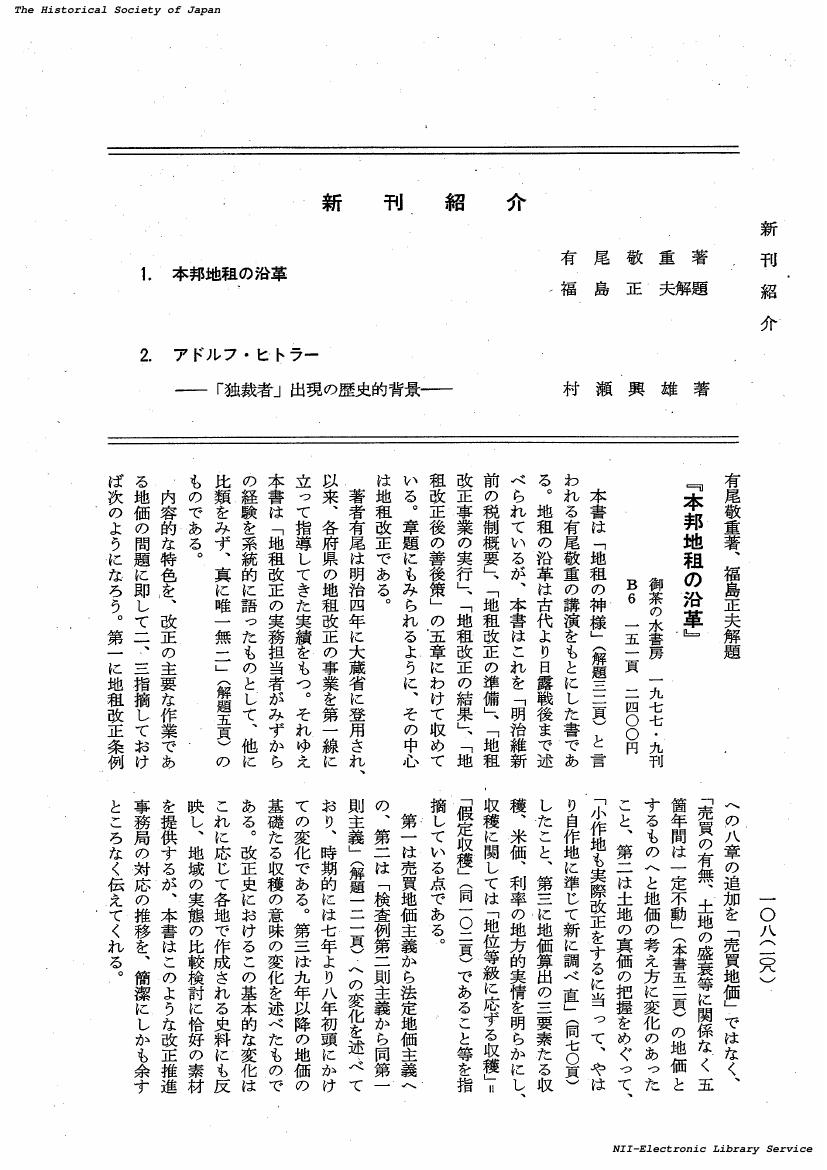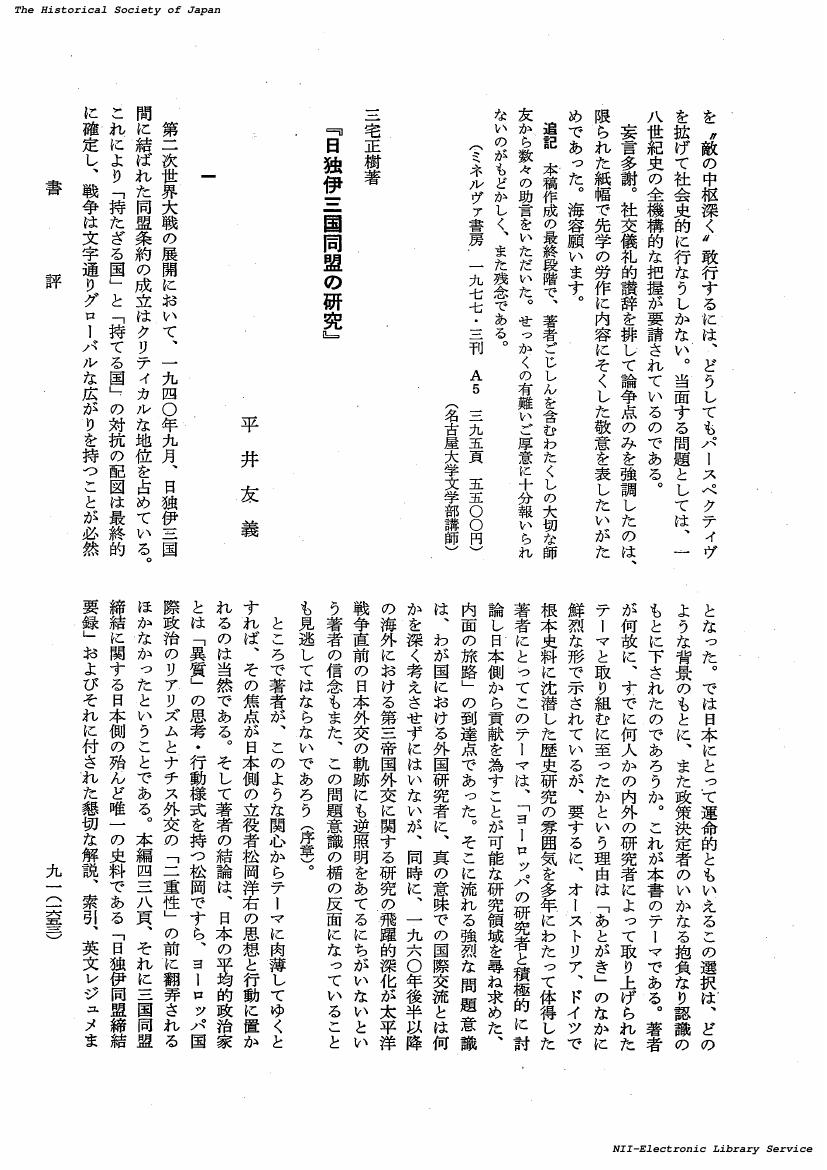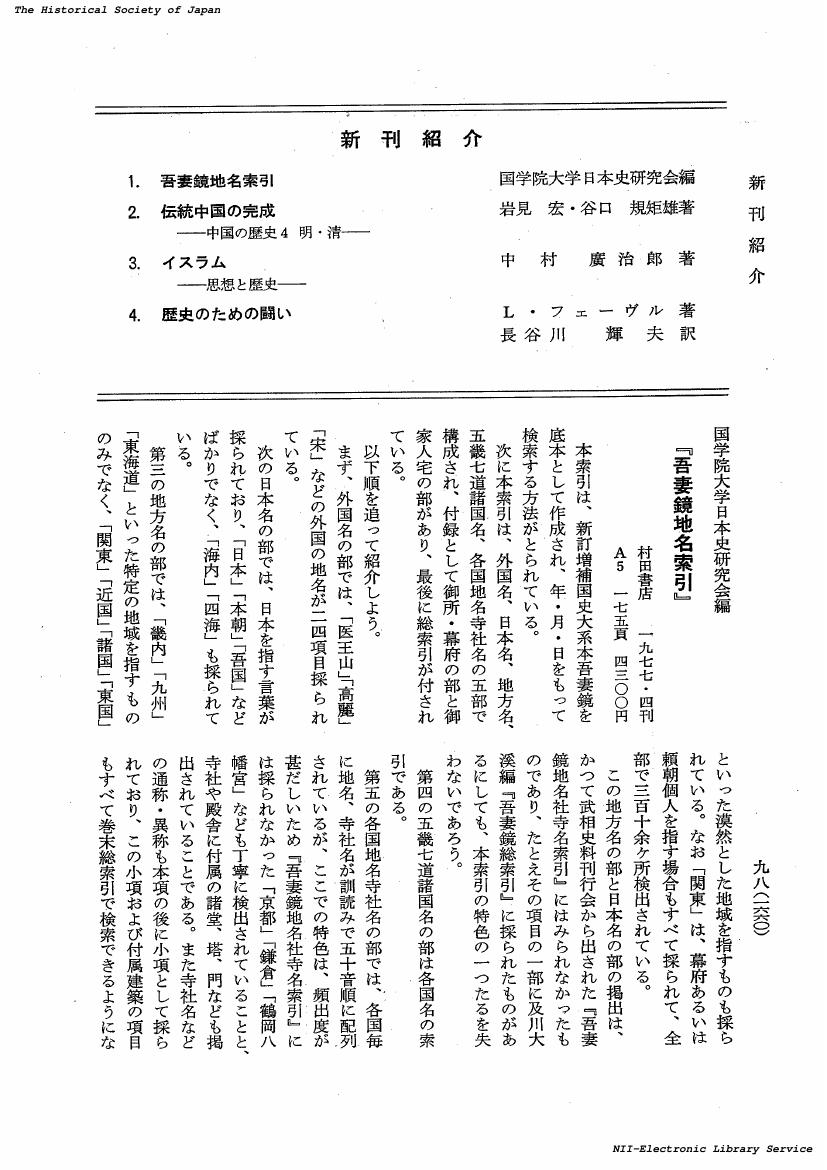- 著者
- 梅村 坦
- 出版者
- 公益財団法人 史学会
- 雑誌
- 史学雑誌 (ISSN:00182478)
- 巻号頁・発行日
- vol.86, no.12, pp.1791-1793, 1977-12-20 (Released:2017-10-05)
- 著者
- 渡辺 隆喜
- 出版者
- 公益財団法人 史学会
- 雑誌
- 史学雑誌 (ISSN:00182478)
- 巻号頁・発行日
- vol.87, no.1, pp.108-109, 1978-01-20 (Released:2017-10-05)
1 0 0 0 OA 「ネップ」初期研究 : 「商品交換体制」の成立をめぐって
- 著者
- 石井 規衛
- 出版者
- 公益財団法人 史学会
- 雑誌
- 史学雑誌 (ISSN:00182478)
- 巻号頁・発行日
- vol.86, no.12, pp.1691-1734,1817, 1977-12-20 (Released:2017-10-05)
1 0 0 0 OA 仲手川良雄著『ブルクハルト史学と現代』
- 著者
- 坂井 直芳
- 出版者
- 公益財団法人 史学会
- 雑誌
- 史学雑誌 (ISSN:00182478)
- 巻号頁・発行日
- vol.86, no.12, pp.1755-1764, 1977-12-20 (Released:2017-10-05)
1 0 0 0 OA 佐脇栄智著『後北条氏の基礎研究』
- 著者
- 池上 裕子
- 出版者
- 公益財団法人 史学会
- 雑誌
- 史学雑誌 (ISSN:00182478)
- 巻号頁・発行日
- vol.86, no.12, pp.1735-1741, 1977-12-20 (Released:2017-10-05)
- 著者
- 志垣 嘉夫
- 出版者
- 公益財団法人 史学会
- 雑誌
- 史学雑誌 (ISSN:00182478)
- 巻号頁・発行日
- vol.86, no.11, pp.1663-1664, 1977-11-20 (Released:2017-10-05)
1 0 0 0 OA 小坂 博之著『山名常〓と禅刹』, 楞厳寺, 一九七六・九刊, A5, 二三〇頁
- 著者
- 田中 博美
- 出版者
- 公益財団法人 史学会
- 雑誌
- 史学雑誌 (ISSN:00182478)
- 巻号頁・発行日
- vol.86, no.12, pp.1788-1790, 1977-12-20 (Released:2017-10-05)
- 著者
- 内河 久平
- 出版者
- 公益財団法人 史学会
- 雑誌
- 史学雑誌 (ISSN:00182478)
- 巻号頁・発行日
- vol.86, no.12, pp.1790-1791, 1977-12-20 (Released:2017-10-05)
1 0 0 0 OA 庄内藩の寛政改革と農村構造
- 著者
- 吉村 仁作
- 出版者
- 公益財団法人 史学会
- 雑誌
- 史学雑誌 (ISSN:00182478)
- 巻号頁・発行日
- vol.86, no.11, pp.1563-1596,1690-, 1977-11-20 (Released:2017-10-05)
This article is intended to examine the basic agrarian policy executed in the end of the 18th century and the early part of the 19th century in the Shonai clan, and through it to throw light upon the characteristics of the social structure of the rural community at the period. The Shonai clan at that period, especially in the end of the 18th century when the Kansei Reform was started, saw the devastation of the rural community so terrible that an expression of a "structural crisis" is given to it. The devastation was concretely shown in the collapse of agriculture management under the severe exploitation, the joint management by the village community of the lands whose occupiers ran off, the exploitation by the usurious capital, the yoke of the organization for tax collection, the accumulation of land by landowners, and so on. The clan confronted with those problems tried to restore the village community by the adjustment of the government organization, the reorganization of the mercantile and usurious capitalists, the policy of land redemption, that is the one of settling occupiers on their lands, and so forth. The social structure of the village community at that period was characterized by the joint operation of deserted lands according to the village customs (mura-sozukuri) and the landowner-tenant relations through the village community. Both were the two manifestations or ways of the same conflict in the village social structure. The policy of settling occupiers on their lands was the basic policy adopted in the reform for maintaining the system of the peasant proper (hon-byakusho). The policy was intended to meet the conflict in the village, but at the same time it could not help being restricted by the village customs. The peasantry had "struggles" by relying upon the customs, and this was the basic form of class conflict at this period. Therefore, however, the decisive aggravation of class conflict waited till the closing years of the Bakufu and the Restoration period when the village community began to gravely disintegrate and reorganize itself. And the trend of poor peasants with various forms of existence in landowner-tenant relations can be used as an index of the aggravation of class conflict.
1 0 0 0 OA 細川行信著『真宗成立史の研究』
- 著者
- 重松 明久
- 出版者
- 公益財団法人 史学会
- 雑誌
- 史学雑誌 (ISSN:00182478)
- 巻号頁・発行日
- vol.86, no.11, pp.1629-1638, 1977-11-20 (Released:2017-10-05)
1 0 0 0 OA 森田 明著『清代水利史研究』
- 著者
- 濱島 敦俊
- 出版者
- 公益財団法人 史学会
- 雑誌
- 史学雑誌 (ISSN:00182478)
- 巻号頁・発行日
- vol.86, no.11, pp.1638-1646, 1977-11-20 (Released:2017-10-05)
1 0 0 0 OA 三宅正樹著『日独伊三国同盟の研究』
- 著者
- 平井 友義
- 出版者
- 公益財団法人 史学会
- 雑誌
- 史学雑誌 (ISSN:00182478)
- 巻号頁・発行日
- vol.86, no.11, pp.1653-1659, 1977-11-20 (Released:2017-10-05)
1 0 0 0 OA 岸田 紀著『ジョン・ウェズリ研究』
- 著者
- 近藤 和彦
- 出版者
- 公益財団法人 史学会
- 雑誌
- 史学雑誌 (ISSN:00182478)
- 巻号頁・発行日
- vol.86, no.11, pp.1646-1653, 1977-11-20 (Released:2017-10-05)
- 著者
- 山本 博也
- 出版者
- 公益財団法人 史学会
- 雑誌
- 史学雑誌 (ISSN:00182478)
- 巻号頁・発行日
- vol.86, no.11, pp.1660-1661, 1977-11-20 (Released:2017-10-05)
- 著者
- 山名 弘史
- 出版者
- 公益財団法人 史学会
- 雑誌
- 史学雑誌 (ISSN:00182478)
- 巻号頁・発行日
- vol.86, no.11, pp.1661-1662, 1977-11-20 (Released:2017-10-05)
1 0 0 0 OA 矢島祐利著『アラビア科学史序説』, 岩波書店, 一九七七・三刊, B6, 四四五頁
- 著者
- 田中 一郎
- 出版者
- 公益財団法人 史学会
- 雑誌
- 史学雑誌 (ISSN:00182478)
- 巻号頁・発行日
- vol.86, no.10, pp.1536, 1977-10-20 (Released:2017-10-05)
- 著者
- 安藤 正人
- 出版者
- 公益財団法人 史学会
- 雑誌
- 史学雑誌 (ISSN:00182478)
- 巻号頁・発行日
- vol.86, no.10, pp.1533-1534, 1977-10-20 (Released:2017-10-05)
1 0 0 0 OA 後藤 靖編『天皇制と民衆』, 東大出版会, 一九七六・一〇刊, 四六判, 二〇七頁
- 著者
- 宮地 正人
- 出版者
- 公益財団法人 史学会
- 雑誌
- 史学雑誌 (ISSN:00182478)
- 巻号頁・発行日
- vol.86, no.10, pp.1534-1535, 1977-10-20 (Released:2017-10-05)
1 0 0 0 OA 数種の昆虫油脂の研究
- 著者
- 小野 忠義 足立 明巳
- 出版者
- Japan Oil Chemists' Society
- 雑誌
- 油化学 (ISSN:18842003)
- 巻号頁・発行日
- vol.8, no.2, pp.72-76, 1959-02-20 (Released:2009-10-09)
- 参考文献数
- 4
- 被引用文献数
- 1
- 著者
- 萩原 正大 山本 正嘉
- 出版者
- 一般社団法人日本体力医学会
- 雑誌
- 体力科學 (ISSN:0039906X)
- 巻号頁・発行日
- vol.60, no.3, pp.327-341, 2011-06-01
- 参考文献数
- 58
- 被引用文献数
- 5
We simulated mountain climbing using walking on a treadmill in order to systematically evaluate the physical load during mountain climbing. The conditions of three types of load-(1) inclination of the walking path (walking uphill and downhill), (2) walking speed, and (3) backpack weight-were varied within the range assumed for normal mountain climbing (40 sets of conditions in total). When the three types of load were expressed as vertical work rate, energy expenditure (VO<sub>2</sub>) during walking uphill and downhill was distributed along roughly the same curve. The following characteristics of walking uphill and downhill were observed.<br>A. Walking uphill<br>For all three types of load, increase in load gave a linear increase in VO<sub>2</sub> and heart rate (HR). A lactate threshold (LT) appeared at an intensity of 62%VO<sub>2max</sub>, when HR was 78% HR<sub>max</sub>. Rating of perceived exertion (RPE) was evaluated for the “Breathlessness” and “Leg Fatigue”, and both of these increased roughly in proportion to %VO<sub>2max</sub>.<br>B. Walking downhill<br>When walking downhill, VO<sub>2</sub> was 35-50% the intensity of VO<sub>2</sub> when walking uphill on the same slope and at the same speed. Energy expenditure did not exceed 60%VO<sub>2max</sub> in any of the load conditions, and no LT was seen. RPE values were higher for walking downhill than walking uphill, even when %VO<sub>2max</sub> values were the same. RPE values for the “Leg Fatigue” tended to be higher than for the “Breathlessness” at the same speed in downhill walking.<br>Using these data, we created a table giving the intensity of exercise of mountain climbing expressed as VO<sub>2</sub> per unit body mass and metabolic equivalents (Mets) with vertical migration velocity and total weight (Body weight + Backpack weight) as variables. This table gives mountain climbers a systematic understanding of the physical load under various mountain climbing conditions. It is likely to be of use as a reference for mountain climbers of different levels of physical fitness when practicing mountain climbing appropriate to their individual level. The present results suggest that in downhill walking, it is insufficient to express the physical load in energy expenditure (VO<sub>2</sub> and Mets) alone, and the load on the leg muscles must also be judged using the RPE in the “Leg Fatigue”.

















